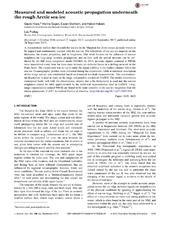Measured and modeled acoustic propagation underneath the rough Arctic sea-ice
Peer reviewed, Journal article
Published version

Åpne
Permanent lenke
https://hdl.handle.net/1956/18858Utgivelsesdato
2017-09Metadata
Vis full innførselSamlinger
- Department of Earth Science [1050]
Originalversjon
https://doi.org/10.1121/1.5003786Sammendrag
A characteristic surface duct beneath the sea-ice in the Marginal Ice Zone causes acoustic waves to be trapped and continuously interact with the sea-ice. The reflectivity of the sea-ice depends on the thickness, the elastic properties, and its roughness. This work focuses on the influence of sea-ice roughness on long-range acoustic propagation, and on how well the arrival structure can be predicted by the full wave integration model OASES. In 2013, acoustic signals centered at 900 Hz were transmitted every hour for three days between ice-tethered buoys in a drifting network in the Fram Strait. The experiment was set up to study the signal stability in the surface channel below the sea-ice. Oceanographic profiles were collected during the experiment, while a statistical description of the rough sea-ice was established based on historical ice-draft measurements. This environmental description is used as input to the range independent version of OASES. The model simulations correspond fairly well with the observations, despite that a flat bathymetry is used and the sea-ice roughness cannot be fully approximated by the statistical representation used in OASES. Longrange transmissions around 900 Hz are found to be more sensitive to the sea-ice roughness than the elastic parameters.